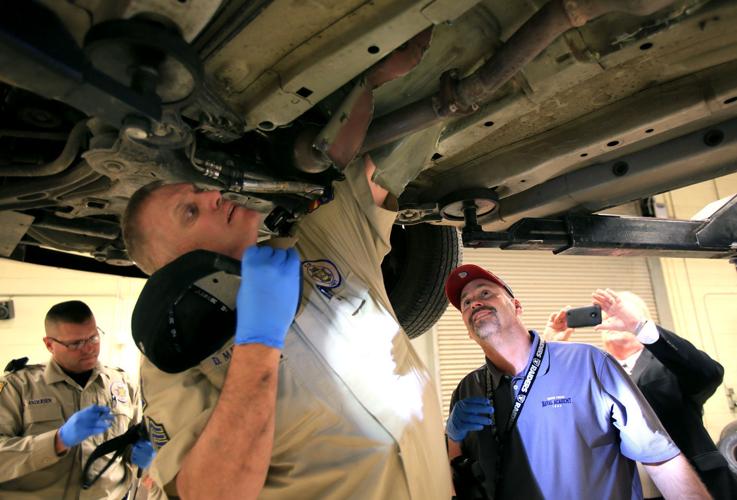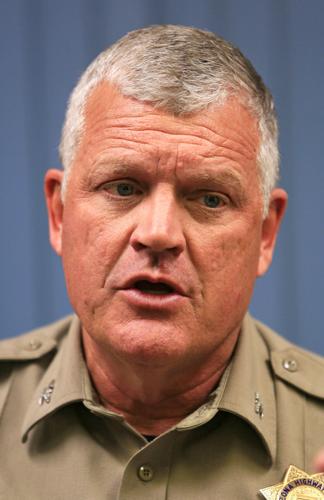A state trooper stopped a sedan loaded with cocaine hours after the driver passed through a port of entry undetected in what state officials hold up as a model of how a new border strike force will operate.
“You want evidence drugs are getting through? This is our quantifiable evidence,” said Capt. Damon Cecil as troopers at the Arizona Department of Public Safety’s office on South Tucson Boulevard removed 20 pounds of cocaine from a hidden compartment under the sedan’s floorboards.
Customs officers at an understaffed port of entry in Nogales missed the suspected smuggler on the morning of Feb. 4, but the trooper stopped her on a highway, and a dog alerted to the drugs, Cecil said.
Moments earlier, DPS Director Frank Milstead chatted with the news media about the details of the Border Strike Force Bureau, which has operated since September and could receive $31.5 million in funding from the Legislature.
“This border strike force isn’t a bunch of guys standing on the border with binoculars waiting for the big load to come across,” Milstead said. “Most of the operations we’re working right now, we’re working in the middle of the state.”
The overall goal of the strike force is to use DPS’ statewide reach to “attack the supply chain of narcotics entering the state,” Milstead said. The strike force is needed to provide “consistency” among agencies dealing with cross-border smuggling, he said.
The strike force coordinated two major operations in Pinal County and another in Cochise County, the results of which were cited in Gov. Doug Ducey’s State of the State address, DPS officials said.
Due to security concerns, DPS officials said they could not release details of the operations, other than to say they would not have happened without the strike force’s involvement.
The strike force also provides interdiction training for all troopers and cleared hilltops of spotters working for drug cartels, who spend months at a time keeping tabs on drug loads and law enforcement in remote areas.
“When they all went home for Christmas, we went up and eradicated their housing arrangements,” Milstead said.
The $31.5 million would allow them to switch from ad-hoc operations to more permanent operations, Milstead said.
A line-item budget submitted by DPS to the Governor’s Office stated the bureau would need 23 positions, at an annual cost of $3.46 million.
Another $1.16 million would go toward professional or indirect positions and eight positions in a category labeled “task force.”
Initially, Milstead had estimated the strike force needed about 200 troopers, but he said that number was based on the best-possible funding scenario.
Instead, the department decided to start small and build on “proven successes,” he said.
In terms of initial overhead, DPS anticipates spending $3.5 million to update communications systems, $4.3 million for vehicles and equipment, and $50,000 on service dogs.
After the $20 million in startup costs, DPS anticipates the strike force will cost taxpayers $10 million annually.
The announcement of the strike force’s creation prompted the Arizona Sheriffs Association to write a strongly worded letter.
Milstead said the strike force is “all carrot and no stick” for the sheriffs, who are not required to participate.
Some of the funds will be used to hire more sheriff’s deputies in border counties to work on strike force activities, Milstead said.
The $31.5 million also includes $2.26 million annually to provide 24-hour DPS patrols of border county highways, which has not been done in rural Arizona for years.
Highways north of the border counties will not see 24-hour patrols until at least after next year’s budget cycle, Milstead said.
Despite the importance of the issue, “We don’t have the dollars right now,” Milstead said.
The budget includes $500,000 to reimburse counties for prosecutions and jail space to cover the costs of cases brought by the strike force.
Border county prosecutors routinely auction vehicles, houses and other assets seized at ports of entry or at federal checkpoints. In Santa Cruz County, those seizures amount to about $1 million annually.
The plan is for law enforcement agencies that make busts to receive 80 percent of the proceeds of seized asset sales with the remaining 20 percent going to county or state prosecutors, Milstead said.
He said he hopes the proceeds get rolled back into the strike force, but no final decision has been made.
There is no way to predict how much in seized assets the strike force will get, Milstead said.
The aviation unit is by far the most costly element of the strike force, the budget shows.
Seven positions, at $927,000, would staff the unit, but the largest cost comes from $1.8 million for aviation facilities and $10.3 million for aviation equipment.
U.S. Customs and Border Protection made four Blackhawk helicopters available to the strike force, and the Department of Defense gave the strike force surveillance aircraft that were used in Afghanistan, Milstead said.
So far, treatment for drug abuse is part of the strike force proposal, but no money has been set aside to fund it, Milstead said.







